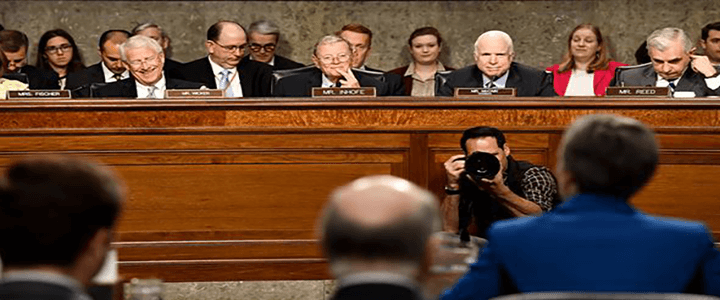The Senate Armed Services Committee will hold two hearings this week, to consider nominations for key defense posts. On Tuesday, the committee will question Richard V. Spencer, President Trump’s choice for secretary of the Navy. On Wednesday, they will examine four nominees: Ryan McCarthy for under secretary of the Army, Owen West for assistant secretary of defense for special operations/low intensity conflict and interdependent capabilities, Charles Douglas Stimson to be general counsel for the Department of the Navy, and David Joel Trachtenberg to be principal deputy under secretary of defense for policy.
These will be just the sixth and seventh hearings the committee has held on Trump nominations to fill the 52 high-level positions in the Department of Defense and the military departments that require Senate confirmation. The president has formally nominated people for 23 of these positions. The Senate has confirmed only six.
ARMY STILL NEEDS A CIVILIAN LEADER
If Spencer is confirmed, only the Army will still be lacking a secretary, although not for lack of trying. President Trump’s first choice for Secretary of the Army was businessman Vincent Viola, a graduate of West Point and owner of the Florida Panthers hockey team. Viola withdrew his nomination in March after he concluded that the difficulties in separating himself from his business and investment empire had “proven insurmountable.”
The president next considered Tennessee state senator Mark Green, also a West Point alumnus and an Iraq War veteran. The administration announced the president’s “intent” to nominate him on April 7. But Green quickly came under fire for controversial past statements about gays and Muslims, among others. Green “withdrew” on May 5, although the White House never officially submitted his nomination to the Senate.
Robert M. Speer, who became President Obama’s assistant secretary of the Army for financial management and comptroller in 2014, has been the acting secretary since Inauguration Day.
OTHER KEY DOD POSITIONS ALSO VACANT
Directly beneath the secretary and deputy secretaries of defense, there are five under secretaries: policy, intelligence, comptroller, personnel & readiness, and acquisition, technology & logistics. The latter will split into two under secretary offices next year as Congress mandated in the FY2017 NDAA.
To date, the administration has only filled the comptrollers job and submitted a nomination for the AT&L role. The Senate confirmed David L. Norquist on May 25 to be comptroller, and the president nominated Ellen M. Lord to be USD(AT&L) on June 29. One principal deputy under secretary, Kari A. Bingen, is in place in the intelligence office.
The president is doing himself a disservice in leaving these positions open for so long. These positions are responsible for formulating policy. The deputy assistant secretaries whom the president nominates but who do not need Senate approval, the career civil servants who form the bulk of the department’s civilian workforce, and the military officers in the Pentagon all execute policy, and provide the subject matter expertise that informs policy development. But the system is designed so that only those to whom the Senate has given its advise and consent can approve those policies.
The White House has previously signaled that some positions across the administration will remain unfilled. That may be a smart long-term strategy for shrinking the size of the Federal bureaucracy. But while the nations remains at war, and faces other threats like North Korea and Iran in the near term, the nation deserves a Department of Defense that is adequately staffed to continue its vital work.
The department’s military and civilian personnel deserve more clarity on the president’s intentions for their future.




